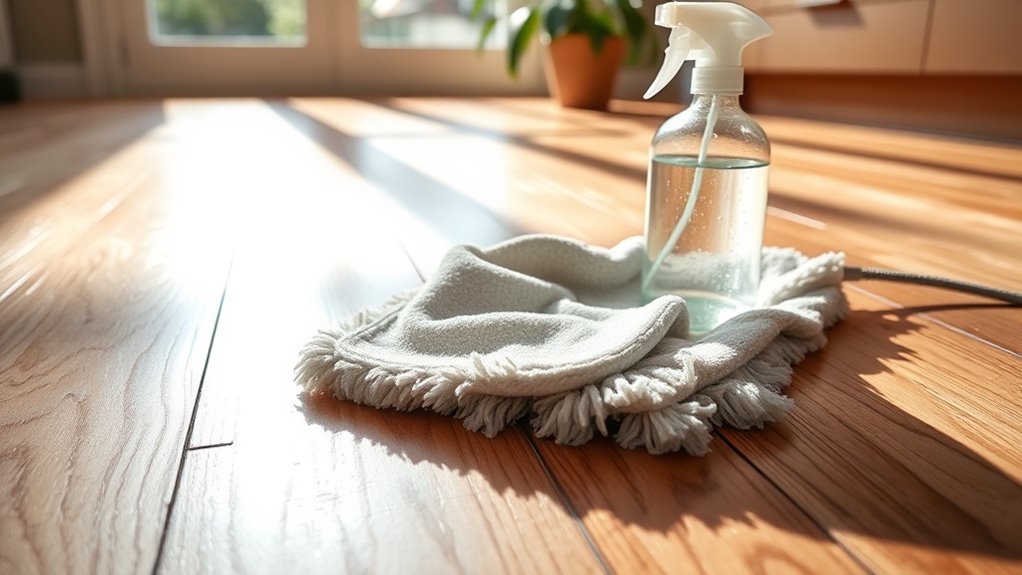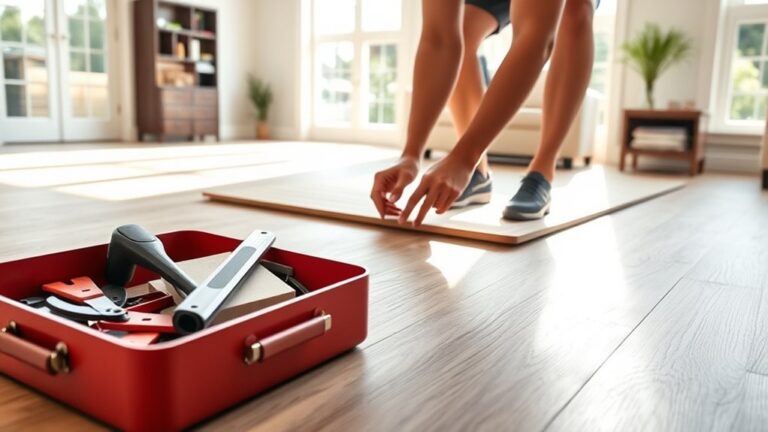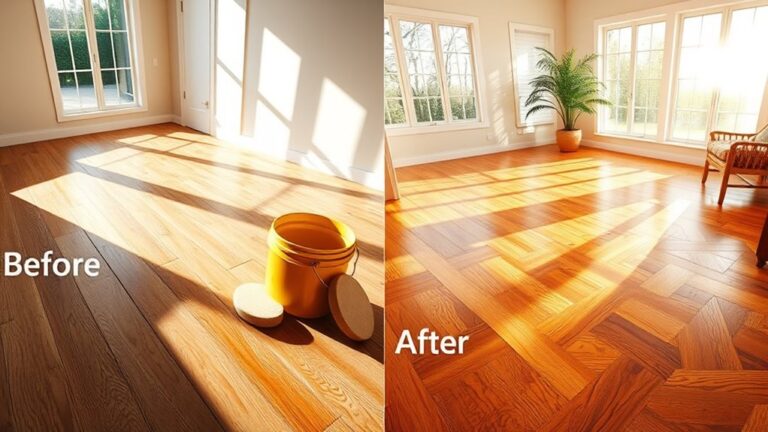To safely clean non-waterproof laminate floors, use a microfiber mop that’s only slightly damp to avoid excess moisture. Sweep or vacuum first with a soft brush attachment to remove dust and debris. Choose gentle, pH-balanced cleaners or mild homemade solutions like diluted vinegar, and never saturate the floor. Avoid harsh chemicals, steam cleaners, and wax products that can damage the surface. Following these tips will help you maintain your floor’s look and durability longer, with more detailed guidance available.
Understanding the Sensitivity of Non-Waterproof Laminate Floors
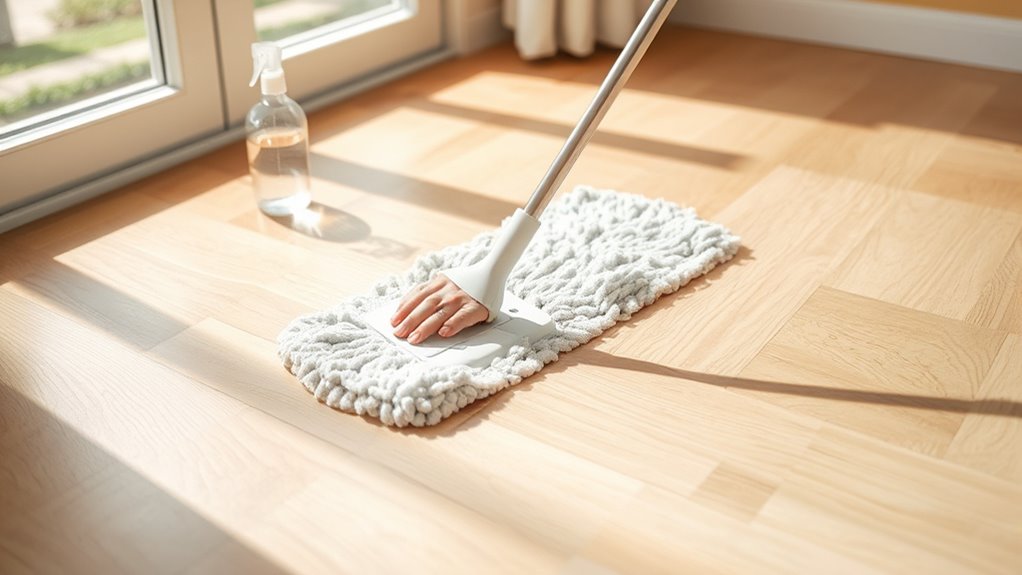
Although laminate floors offer durability and style, non-waterproof varieties require extra care because they’re vulnerable to moisture damage. You need to understand that water sensitivity is a key factor affecting laminate durability. When water seeps into the seams or surface, it can cause swelling, warping, and permanent damage. Unlike waterproof laminate, these floors don’t tolerate wet cleaning methods or spills left unattended. To maintain their strength and appearance, you must limit exposure to liquids and clean using minimal moisture. This knowledge empowers you to protect your floors effectively while enjoying the freedom of a stylish, durable surface. By respecting the water sensitivity of non-waterproof laminate, you’ll extend its lifespan and keep your living space looking sharp without unnecessary restrictions.
Essential Cleaning Tools for Laminate Floors
Three essential tools can make cleaning your laminate floors both efficient and safe. Since laminate materials aren’t waterproof, choosing the right cleaning tools is vital to avoid damage. You’ll want a microfiber mop for gentle, effective cleaning without excess water, a soft-bristle broom for delicate dusting, and a spray bottle to control moisture application precisely.
| Tool | Purpose | Why It Works for Laminate Materials |
|---|---|---|
| Microfiber Mop | Clean with minimal water | Absorbs moisture, prevents water damage |
| Soft-bristle Broom | Dust and debris removal | Gentle on laminate, avoids scratching |
| Spray Bottle | Controlled moisture | Applies liquid sparingly, prevents flooding |
| Dry Cloth | Spot cleaning | Removes stains without soaking the surface |
| Dustpan | Collect debris | Helps maintain cleanliness without mess |
Using these cleaning tools respects your floors’ sensitivity, ensuring long-lasting beauty and freedom from worry.
How to Remove Dust and Loose Dirt Safely
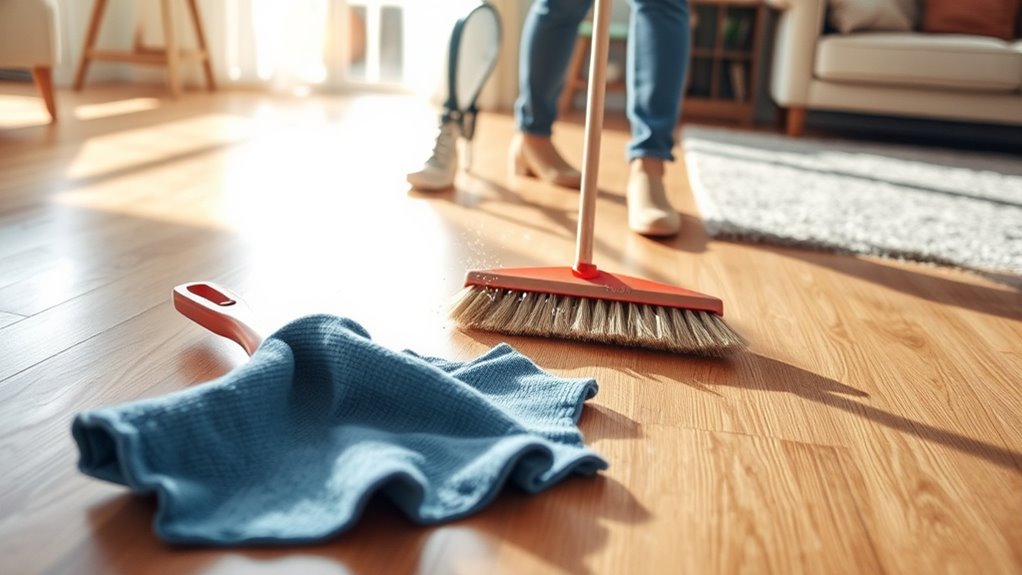
Before you start mopping, it’s important to remove dust and loose dirt to prevent scratches on your laminate floors. Begin with a soft microfiber dust mop or a vacuum designed for hard floors to guarantee effective dust removal without damaging the surface. Avoid vacuums with beater bars, as they can cause scratches. Move systematically, covering the entire floor to gather all dirt collection, especially in corners and along baseboards. Regularly clean your dust mop to avoid redistributing dust. For stubborn dirt, gently sweep with a soft-bristled broom before vacuuming. This careful approach keeps your floors free from abrasive particles that could wear down the laminate finish, maintaining the floor’s appearance while giving you the freedom to enjoy a clean, scratch-free space.
Choosing the Right Cleaning Solutions
When selecting cleaning solutions for your laminate floors, it is crucial to choose products that won’t damage the surface or leave residue behind. Avoid harsh chemicals or abrasive cleaners, as they can strip the protective layer and cause warping. Eco friendly options are ideal since they’re gentle yet effective, reducing chemical exposure and environmental impact. You might also consider homemade cleaners made from simple ingredients like diluted white vinegar or mild dish soap mixed with water. These solutions clean well without excess moisture or harmful additives. Always apply cleaners with a damp, not wet, cloth or mop to prevent water seepage. By choosing the right cleaning solutions, you maintain your floor’s integrity and enjoy a fresh, safe living space without sacrificing freedom in your cleaning routine.
Step-by-Step Guide to Spot Cleaning Stains
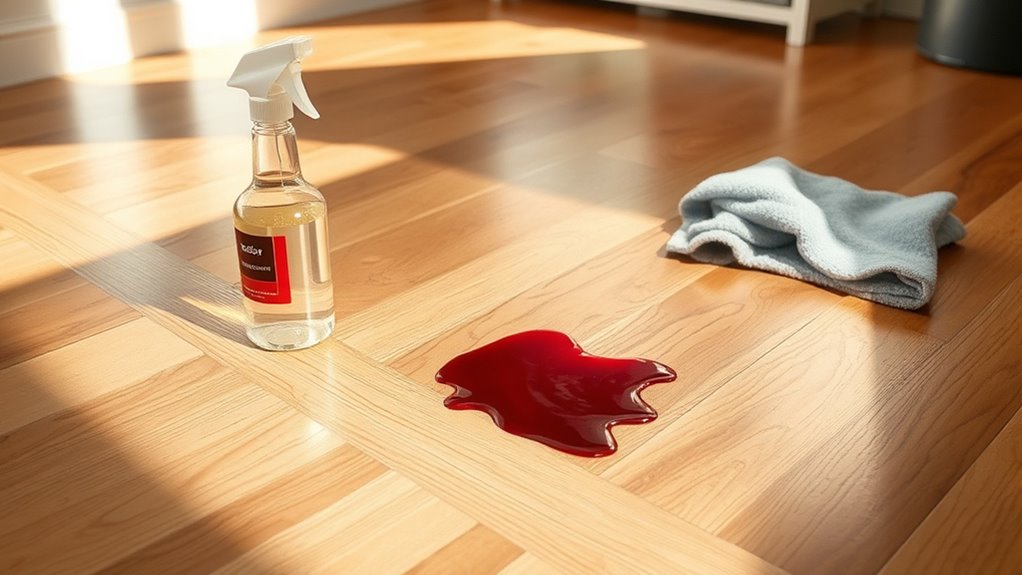
Spot cleaning stains on laminate floors requires a careful approach to avoid damage while effectively removing marks. For successful stain removal, use gentle spot treatment methods with minimal moisture.
| Step | Action |
|---|---|
| 1 | Blot fresh stains with a dry cloth—don’t rub. |
| 2 | Apply a small amount of mild detergent mixed with water to the area. |
| 3 | Gently scrub with a soft cloth or sponge in a circular motion. |
| 4 | Wipe dry immediately to prevent water damage. |
Avoid harsh chemicals or excessive water to protect your laminate. This controlled spot treatment guarantees freedom from stains without risking your floor’s finish. Always test your cleaning solution on a hidden spot first to confirm it won’t cause discoloration or damage.
Proper Techniques for Mopping Laminate Floors
When mopping laminate floors, it’s essential to choose cleaning solutions that won’t damage the surface or leave residue. Avoid using excessive water or steam mops, as moisture can cause warping. Stick to gentle, damp mopping methods to keep your floors looking their best.
Choosing Safe Cleaning Solutions
Although laminate floors are durable, using the wrong cleaning solutions can cause damage over time. You’ll want to pick eco friendly options and pH balanced cleaners to maintain your floor’s finish and avoid warping. Harsh chemicals or abrasive products can strip the protective layer, so stick to gentle, effective solutions.
| Cleaner Type | Benefits |
|---|---|
| pH Balanced Cleaners | Safe, non-damaging, effective |
| Eco Friendly Options | Environmentally safe, gentle |
| Avoid Ammonia-Based | Can dull and damage laminate |
| Avoid Bleach | Causes discoloration, weakens |
Choosing wisely lets you enjoy a clean floor and the freedom to live without worry about costly repairs.
Mopping Methods to Avoid
Since laminate floors are sensitive to moisture, you shouldn’t use soaking wet mops or excessive water when cleaning. Avoid traditional string mops or heavy sponge mops that hold too much liquid, as they can saturate the floor and cause warping. Instead, opt for microfiber mops designed to use minimal water. Also, steer clear of steam mops; the high heat and moisture can damage the laminate’s surface. When it comes to cleaning frequency, don’t overdo it—excessive mopping can wear down the finish. Aim for regular dry or slightly damp mopping to maintain freedom from dirt without risking damage. By choosing the right mop types and limiting how often you clean, you’ll keep your laminate floors looking great without compromising their integrity.
Preventing Water Damage During Cleaning
Because laminate floors are sensitive to moisture, you’ll need to minimize water exposure during cleaning to prevent warping or swelling. Understanding water absorption risks helps you choose effective moisture control methods that keep your floors safe. Avoid soaking your mop or using excessive water, and always wring out cleaning tools thoroughly.
| Moisture Control Method | Why It Matters |
|---|---|
| Damp mop with microfiber | Limits water contact |
| Quick drying | Prevents prolonged moisture |
| Use spray bottles | Controls solution application |
| Avoid standing water | Stops water absorption risks |
Tips for Maintaining Laminate Floors Between Cleanings
Keeping water exposure to a minimum during cleaning helps protect your laminate floors, but regular care between cleanings is just as important. To keep your floors looking great, focus on these key tips for maintaining them:
Minimize water during cleaning and maintain regular care to keep laminate floors looking their best.
- Sweep or vacuum regularly to remove dust and grit that can scratch the surface.
- Use floor protectors on furniture legs to prevent dents and scuffs when moving items around.
- Address spills immediately with a dry or slightly damp cloth to avoid water damage.
Common Mistakes to Avoid When Cleaning Laminate Floors
Although laminate floors are durable, certain cleaning mistakes can cause damage or reduce their lifespan. One of the most common cleaning mistakes is using excessive water. Since laminate isn’t waterproof, excess moisture seeps into seams, causing warping or swelling. Avoid improper mopping techniques like soaking the mop or leaving puddles behind. Instead, use a damp mop with minimal water. Another mistake is harsh chemicals or abrasive cleaners, which can dull or scratch the surface. Stick to pH-neutral cleaners designed for laminate. Avoid steam cleaners and wax-based products—they can damage the protective layer. By steering clear of these common cleaning mistakes and adopting proper methods, you’ll keep your laminate floors looking great without risking costly damage or shortening their life.

